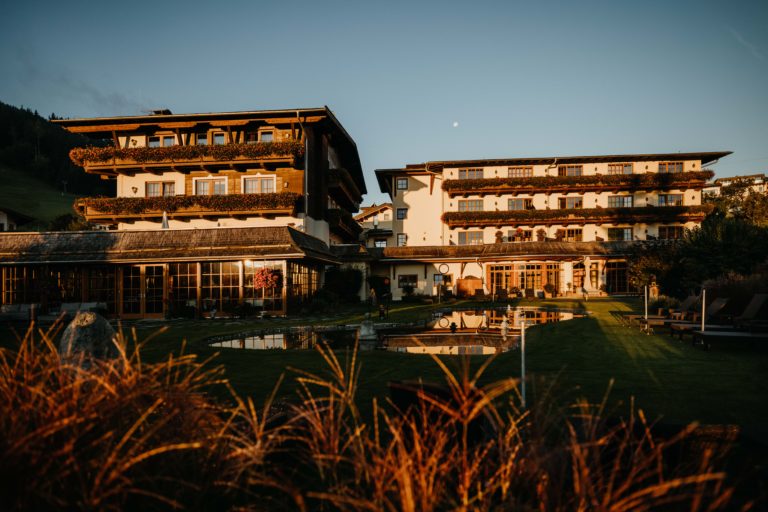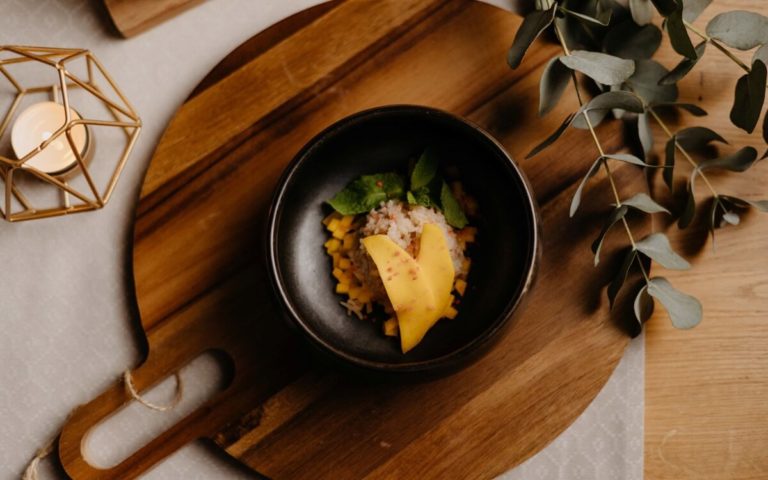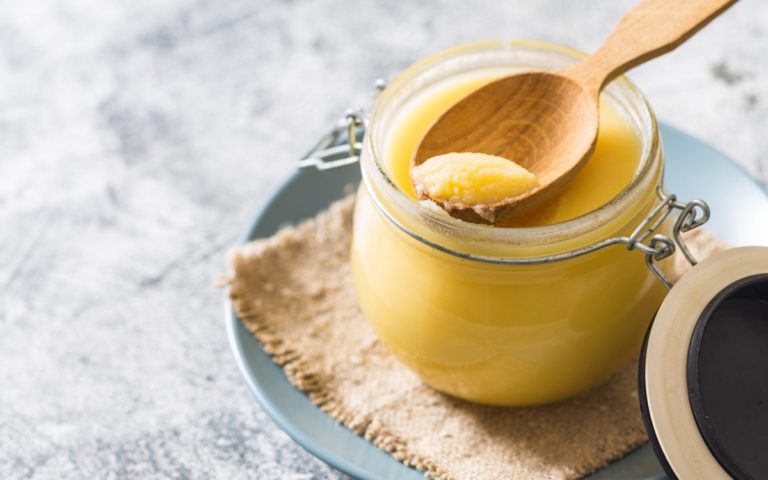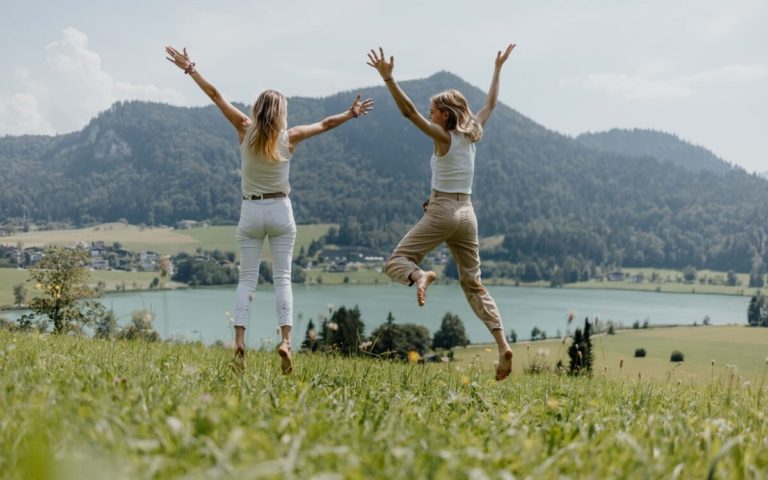If there is one thing that should not be missing in Ayurvedic cuisine, it is definitely ghee! The clarified butter has great advantages over other fats and can be used not only for frying, but also for all kinds of health purposes. But what exactly is ghee? You can find out everything about its use, whether the pure fat is healthy or unhealthy and much more here.
What exactly is ghee?
Basically, this means nothing other than clarified butter, clarified butter or clarified butter . Clarified butter has almost 100 percent fat content, a rich yellow color and a somewhat firmer consistency. The smell is more intense than that of unclarified butter.
During production, the water content evaporates completely and animal protein and lactose are released. This means that it can be kept for a long time without refrigeration, which makes it particularly popular in South Asia and the Middle East. It is traditionally produced in Pakistan and India.
In Ayurveda, it is said to have antioxidant, detoxifying and anti-inflammatory properties. It can be used externally and internally. It is particularly popular in the ketogenic diet.
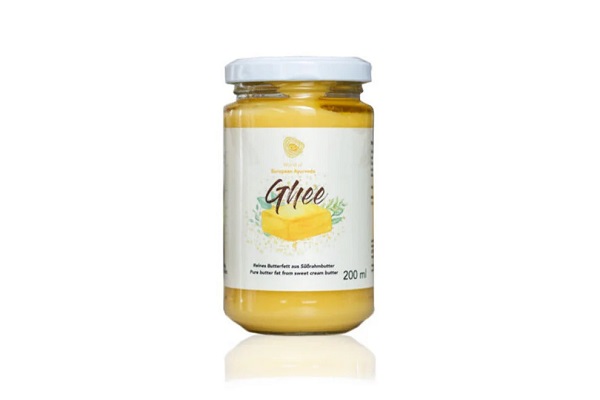

Discover our European Ayurveda® Ghee now
The "liquid gold" of Ayurvedic medicine. In Ayurveda, ghee is considered a food, food supplement and medicine at the same time. Discover it now in our European Ayurveda® online store!
Is ghee healthy or unhealthy?
In fact, ghee is the healthiest of all types of fat that we can use in everyday life. This is because the end result of the manufacturing process contains 70 percent saturated fatty acids.
Contrary to the long-held belief that saturated fatty acids are unhealthy, we now know that the exact opposite is true. The short-chain fatty acids and conjugated linoleic acid (CLA) in particular are easy to digest and provide the body with quick energy.
It is healthy because it contains vitamins D, E and A. However, we have to say that you would have to eat quite a lot to cover your entire daily requirement. The quality of the butter also plays a major role.
However, if consumed in excess, it can - like all fatty acids - promote a fatty liver. (2) Clarified butter contains a lot of cholesterol (approx. 264 g per 100 g of ghee) and should therefore only be consumed in moderation. Is ghee therefore unhealthy? No, in moderation it can have many positive effects, but like all fats it should simply be consumed sparingly.
Is ghee vegan?
Making clarified butter without butter - even Ayurvedic cuisine reaches its limits here. According to the traditional recipe, ghee is therefore not vegan, as it is necessarily made from animal fat.
However, vegan ghee is now also available in more and more health food stores. Alternatively, you can also use high-quality coconut oil instead of butter - vegan Ayurvedic cuisine is happy to help itself with alternatives of this kind.
Advantages of Indian cooking fat
In principle, the health benefits of ghee can be summarized in the following points (3)(5):
- nourishes the body, strengthens the immune system and cardiovascular system
- Dissolves toxins and has cleansing properties
- Cognitive benefits and support for vision
- protects and cares for the skin when applied externally
- supports the health of bones and joints
- brings the doshas into balance
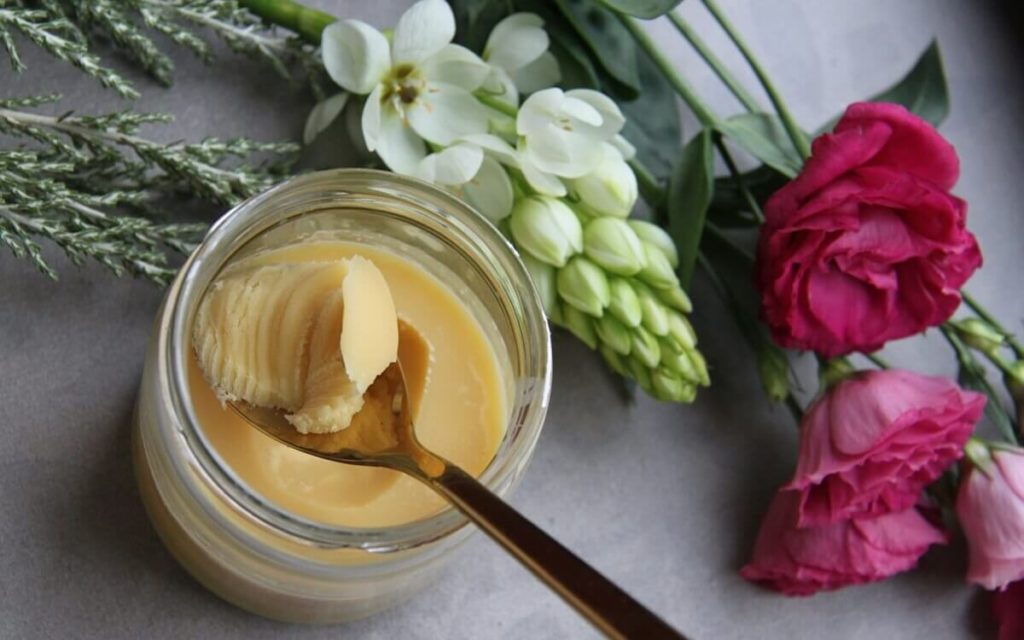

In addition to its health benefits, it is also used in the kitchen. It has the following three advantages:
- can be heated to high temperatures: While liquid butter or other oils burn proteins when heated to high temperatures, this does not happen with hot ghee. Even at well over 100 degrees, the fatty acids remain intact and do not oxidize. This prevents the formation of free radicals, which are generally considered unhealthy.
- Long shelf life: While butter eventually turns rancid, ghee can be kept for weeks, even unrefrigerated.
- suitable for lactose intolerant people: The lactose content of ghee is so low that it can also be consumed by lactose-intolerant people.
Effect and application options
Clarified butter is highly valued in Ayurveda and for good reason! You can use the golden-yellow fat wonderfully for various purposes, be it for cooking, as a medicinal measure or for ayurvedic skin care.
Ghee as clarified butter for cooking
Unlike other fats, you can heat it up without any problems. This is what makes ghee so suitable for cooking.
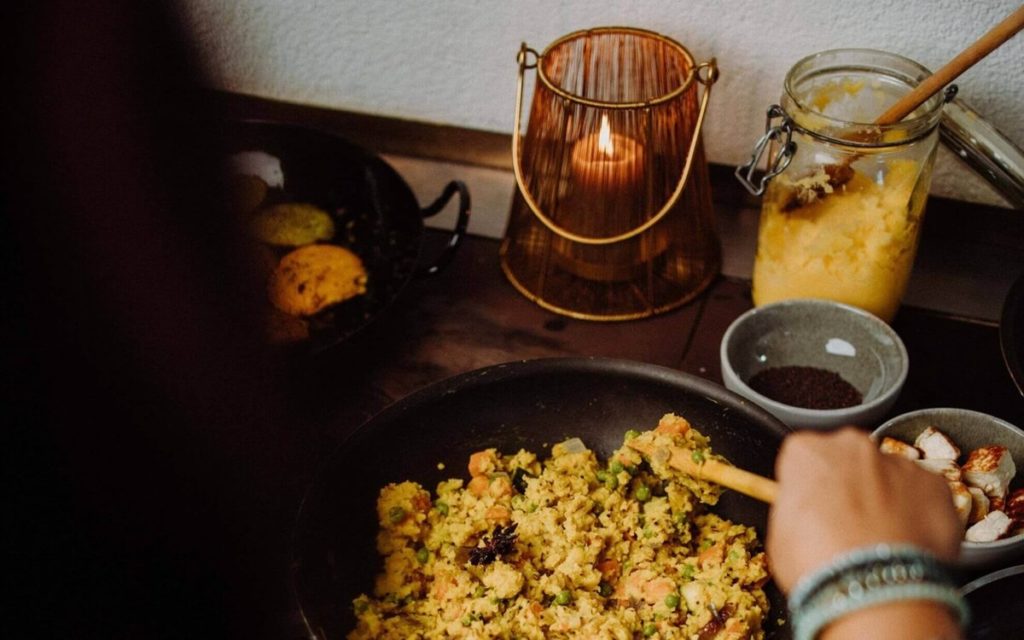

The fatty acids remain stable up to temperatures of 180 °C, so you can use them to sear meat, fish or vegetables. No dangerous trans fatty acids (e.g. acrylamide) are produced, which can cause cardiovascular diseases, among other things.
What's more, it is easy to digest and gives your food a pleasant, mild buttery taste. This is precisely why clarified butter is also good for baking.
But how healthy is ghee? Clarified butter is still pure fat, so you shouldn't overdo it - just as Ayurveda teaches for every area of life anyway.
Ghee effect for intestinal and internal health
When you cook with ghee, your digestive fire, the agni, is happy about it. It is promoted by the Ayurvedic clarified butter and also helps the stomach to regenerate after gastrointestinal inflammation, for example. It is also used for Ayurvedic intestinal cleansing and detoxification.
Ghee can also help with the health of bones and joints, as well as with corresponding illnesses and inflammations. (4)
You can try oil pulling in the morning. Put some ghee in your mouth and swish it through your teeth for 20 minutes. It is very important that you spit it out immediately afterwards and brush your teeth with a separate toothbrush.
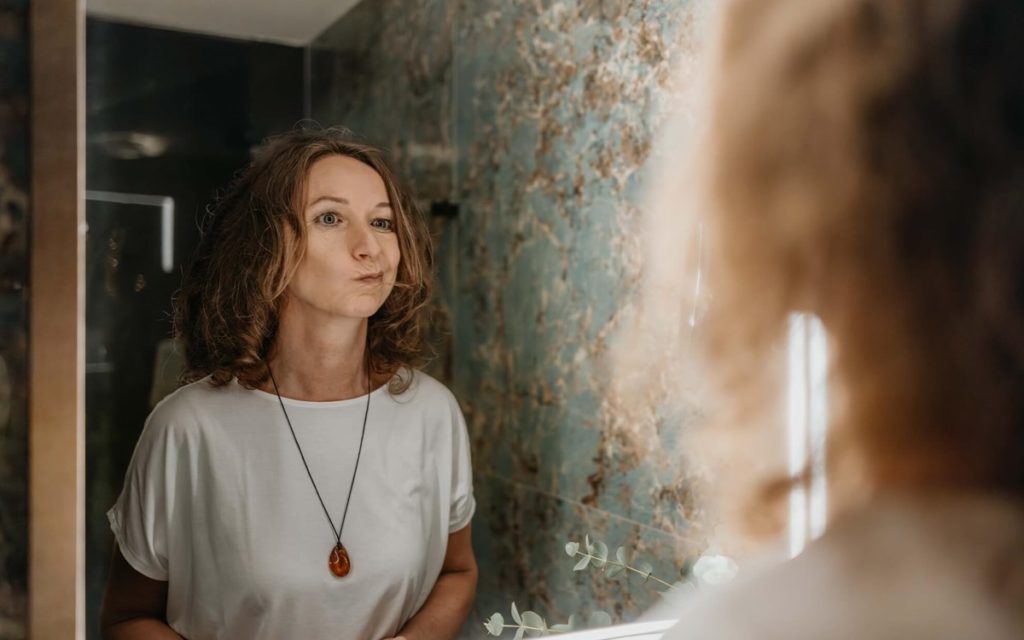

This is because the fat removes toxins from your mouth and throat, which you should logically not swallow again. Oil pulling prevents tooth decay and inflammation. The use of oral care oil is particularly recommended in Ayurvedic hygiene.
Overall, the clarified butter has a detoxifying effect and detoxifies the body, as it binds the toxins in the body and removes them. There is even medicinal ghee: the butter is mixed with Ayurvedic medicinal herbs and simmered for up to 4 days. The herbs are said to have an even more intensive effect. Incidentally, it is said that it can even lower cholesterol levels.
Ghee for external use
Whether internal or external inflammation: You can do a lot with ghee. The anti-inflammatory effect of clarified butter helps, for example, to prevent scars and blistering or reduce redness. You can also use clarified butter to treat psoriasis.
It can also be used in your normal skincare routine, for example the fat is ideal for removing make-up in the evening. Ghee has a soothing effect on the skin, which you can make use of in many situations.
And for a little wellness before going to bed, you can use ghee or a massage oil. Massage the soles of your feet with the oil and treat yourself to a Padabhyanga self-massage. This should help you sleep better.
By the way: Ghee can help against dry eyes (1). Simply heat 2-3 tablespoons of it in a water bath and use a thermometer to make sure that the temperature does not exceed 33 °C. Soak your eyes in liquid ghee for 10 minutes twice a week and the annoying itching and scratching should soon be a thing of the past.
Ghee: Health effects and use in Ayurvedic cures
The Ayurvedic cleansing therapy Panchakarma takes place in two phases: Firstly, a so-called preliminary cure and then the main cure. During the preliminary treatment, waste products and toxins are removed - the agent for this is the pure butter fat ghee. After this preliminary treatment, the first symptoms may subside and lightness and joie de vivre return.
This shows that ghee does have an effect because it binds toxins and the body can successfully eliminate them. This is good for the digestive tract, as it has a regenerating effect, particularly in the stomach, and can promote digestion.
Where can I get ghee buttermilk?
Are you curious to find out for yourself what ghee is all about? Then you now have two options: You can buy it or simply make it yourself.
Where can I buy ghee?
Making high-quality ghee takes time. If your schedule is already full enough or you are not quite ready for the production process, you can buy the finished product quickly and easily in many health food stores. You can also get our original Ayurvedic ghee from certified organic farming from us.
Make it yourself: the recipe
Conveniently, it's not that difficult to make ghee yourself. The most important ingredient is patience! You should allow at least an hour for the preparation and not get distracted during this time.
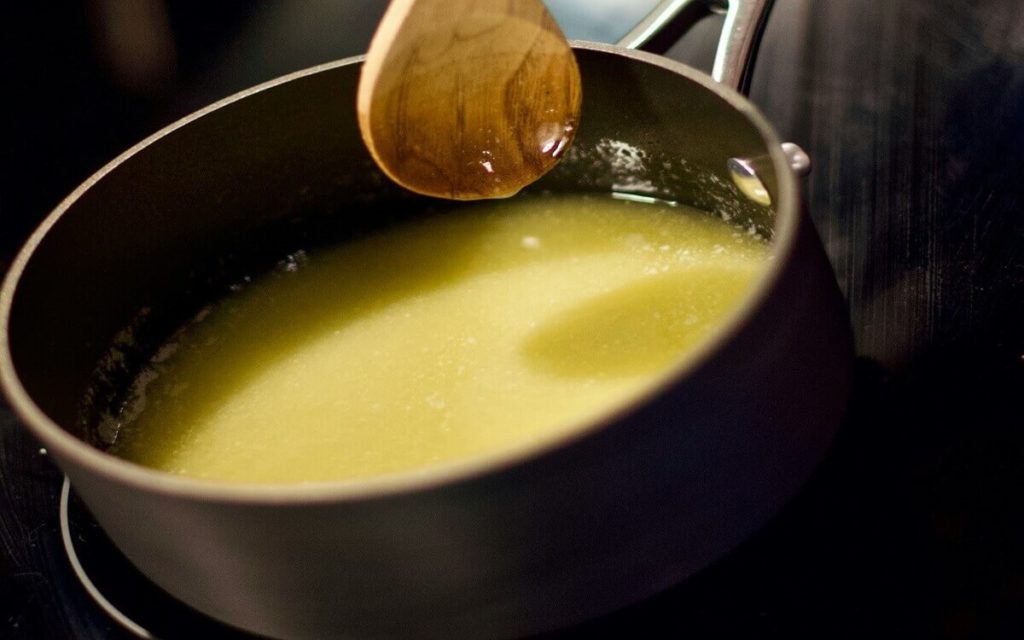

To make ghee you will need:
- Organic pasture butter / sweet cream butter
- A wide pot, ideally made of stainless steel
- A sterile preserving jar with a swing-top lid or a screw-top jar
- A cotton cloth or alternatively a coffee filter
When making ghee, simply follow these step-by-step instructions and everything will work:
(1) Cut the butter into pieces and add it to the pan. It is important that it is not too high in the pot when it is liquid.
(2) Melt the butter over a low heat without letting it brown.
(3) Briefly increase the heat until the butter boils.
(4) Reduce the heat again and leave the butter to simmer for about 30-40 minutes. Depending on the amount of butter, it may take longer - patience is required here, just don't rush it!
(5) Keep skimming off the egg white foam that forms on the surface. The ghee is ready when there is no more foam and the fat has a clear color.
(6) Take the pot off the stove and let it cool for a few seconds. Meanwhile, place the cotton cloth over the opening of your preserving jar.
(7) Pour the ghee through the cloth into the jar. Alternatively, use a coffee filter for straining.
(8) Close the jar tightly. If you have a screw-top jar, you can turn it upside down briefly. This creates a vacuum, which makes the clarified butter last even longer.
You do not need to store the finished ghee in a jar in the fridge, but you should avoid direct sunlight. Make sure you stay at the stove the whole time the fat is simmering so that you can remove the pot from the stove immediately if something burns. You should not stir the butter.
As you can see, making your own ghee is not magic. You may need one or two attempts before you are completely satisfied with the result, but practice makes perfect.
And then all that remains is to try out all the positive effects on your own body - you certainly won't regret it!
Clarified butter: what can you use it for in cooking?
Whenever a recipe mentions frying, roasting and baking, you can also use ghee instead of different types of oil or butter. Just try it out to see if and when it tastes good.
Ghee is also used in Ayurvedic breakfasts and can be incorporated well. Simply stir a tablespoon into porridge, which can give Vata types in particular an energy-rich start to the day.
For all those who like a light breakfast with fruit: It can be fried in a pan, making it easier to digest. Good luck!


Ayurvedic detoxification: methods & home remedies for Ayurvedic detox
Ayurveda detoxification, purification, detox cure - whatever you call it, everyone benefits from an occasional cleansing of the liver and kidneys. In our article, you can find out how you can carry out a small detox at home and which home remedies can help.
Cover picture: © Ivannag82 - istockphoto.com (file no.: 1316599821)
Sources:
(1) Horwarth-Winter, J. et al. (2008): Clarified butter for dry eyes. KlinOptikum 12. URL: https://www.uniklinikumgraz.at/fileadmin/media/lkh-univ-klinikum-graz/Uniklinikum/ueber_uns/Klinoptikum/Klinoptikum-04-2008.pdf
(2) Sedgi, F. et al. (2024): The effects of replacing ghee with rapeseed oil on liver steatosis and enzymes, lipid profile, insulin resistance and anthropometric measurements in patients with non-alcoholic fatty liver disease: a randomized controlled clinical trial. British Journal of Nutrition, 131(12), 1985-1996. doi:10.1017/S0007114524000564.
(3) Kumar, A. et al. (2018): Ghee : Its Properties, Importance and Health Benefits. Lipid Universe, 6, URL: https://www.researchgate.net/profile/Anil-Kumar-233/publication/339499398_Ghee_Its_Properties_Importance_and_Health_Benefits/links/5e562e67299bf1bdb83b26d3/Ghee-Its-Properties-Importance-and-Health-Benefits.pdf.
(4) Falahatzadeh, M. et al. (2024): From tradition to science: Possible mechanisms of ghee in supporting bone and joint health. Prostaglandins & Other Lipid Mediators, 175. doi: https://doi.org/10.1016/j.prostaglandins.2024.106902.
(5) Kataria, D. & Singh, G. (2024): Health benefits of ghee: Review of Ayurveda and modern science perspectives. Journal of Ayurveda and Integrative Medicine, 15 (1), doi: https://doi.org/10.1016/j.jaim.2023.100819.

